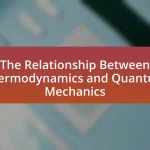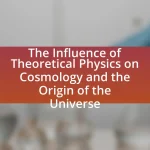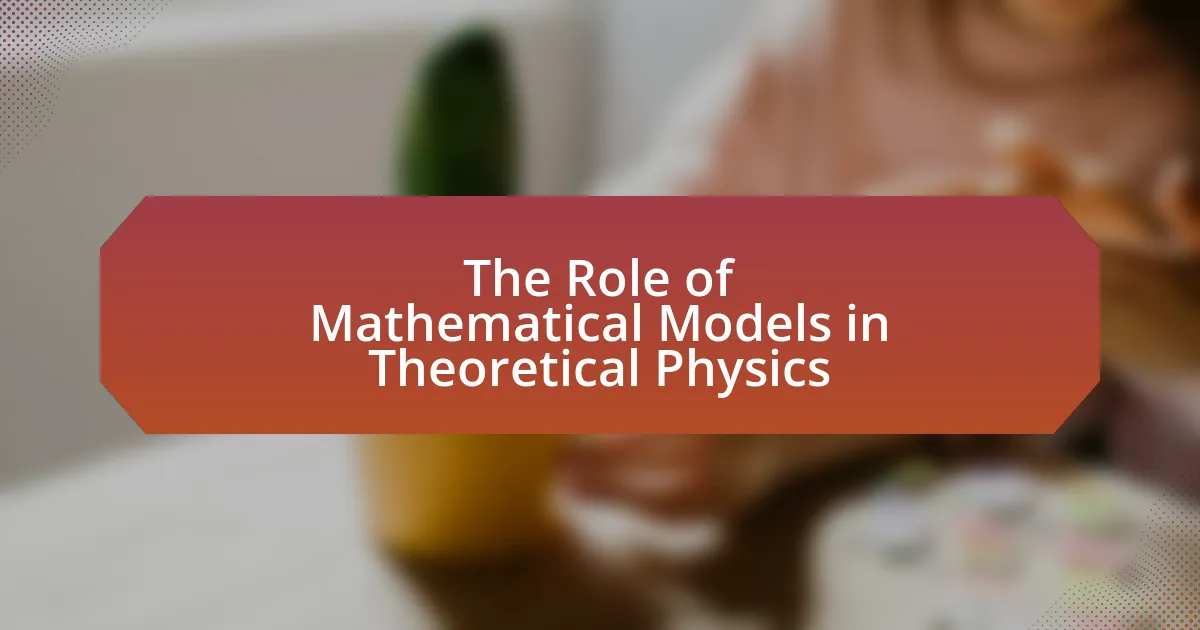Theoretical models of black holes are essential frameworks that describe their properties and behaviors, primarily based on general relativity and quantum mechanics. Key models include the Schwarzschild solution for non-rotating black holes, the Kerr solution for rotating black holes, and the Reissner-Nordström solution for charged black holes. These models explain black hole formation through the gravitational collapse of massive stars and address the information paradox, which questions the fate of information that falls into black holes. The article explores the evolution of these models, their implications for modern astrophysics, and proposed solutions to the information paradox, highlighting the ongoing research and experimental approaches aimed at reconciling quantum mechanics with general relativity.
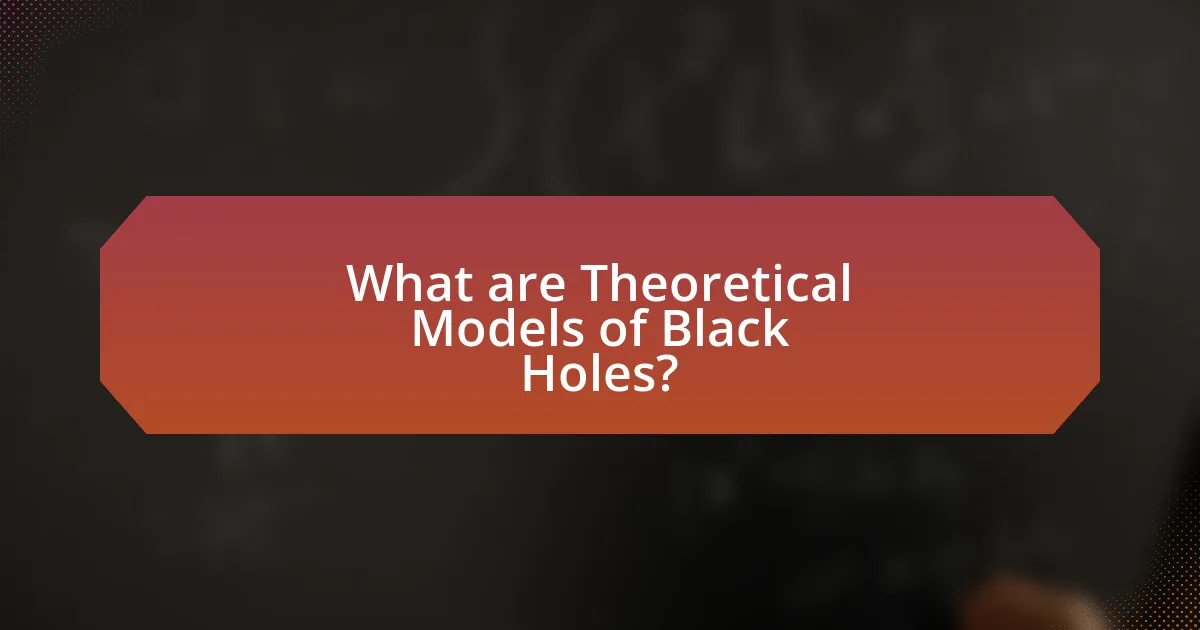
What are Theoretical Models of Black Holes?
Theoretical models of black holes are frameworks that describe the properties and behaviors of black holes based on the principles of physics, particularly general relativity and quantum mechanics. These models include the Schwarzschild solution, which represents a non-rotating black hole, and the Kerr solution, which describes a rotating black hole. Additionally, the Reissner-Nordström solution accounts for charged black holes. Each model provides insights into the structure, event horizon, and singularity of black holes, supported by mathematical equations derived from Einstein’s field equations. The validity of these models is reinforced by astronomical observations, such as the detection of gravitational waves from black hole mergers and the imaging of the black hole in the galaxy M87 by the Event Horizon Telescope, which aligns with predictions made by these theoretical frameworks.
How do these models explain the formation of black holes?
Theoretical models explain the formation of black holes primarily through the gravitational collapse of massive stars. When a star exhausts its nuclear fuel, it can no longer support itself against gravitational forces, leading to a collapse that compresses its core. This process can result in a singularity surrounded by an event horizon, defining a black hole.
General relativity, formulated by Albert Einstein, provides the mathematical framework for understanding this phenomenon, predicting that if a star’s mass exceeds a certain limit (the Tolman-Oppenheimer-Volkoff limit), it will inevitably collapse into a black hole. Observational evidence, such as the detection of gravitational waves from merging black holes and the imaging of the event horizon of the supermassive black hole in M87 by the Event Horizon Telescope, supports these models.
What are the key characteristics of different black hole models?
Different black hole models exhibit key characteristics that define their structure and behavior. The Schwarzschild black hole, for instance, is a non-rotating, uncharged black hole characterized by a singularity at its center and an event horizon that marks the boundary beyond which nothing can escape. In contrast, the Kerr black hole is a rotating black hole that possesses angular momentum, leading to an oblate shape and the presence of an ergosphere, where objects cannot remain in place. The Reissner-Nordström black hole, which is charged, features both an event horizon and an inner Cauchy horizon, allowing for unique electromagnetic interactions. Lastly, the more speculative models, such as the fuzzball concept from string theory, suggest that black holes may not have singularities but rather are composed of a vast number of strings, fundamentally altering our understanding of their internal structure. These characteristics are essential for understanding the implications of black holes in the context of the information paradox and theoretical physics.
How do these models differ in their predictions about black hole behavior?
Different theoretical models of black holes, such as general relativity and quantum gravity, predict varying behaviors regarding information retention and event horizons. General relativity suggests that information is lost when matter crosses the event horizon, leading to the information paradox, while quantum gravity models, like string theory, propose that information may be preserved and encoded on the event horizon, allowing for retrieval. This divergence is supported by ongoing debates in theoretical physics, where studies indicate that reconciling these models could resolve the paradox, as seen in works by Hawking and others who explore the implications of black hole thermodynamics.
Why are theoretical models important in understanding black holes?
Theoretical models are crucial for understanding black holes because they provide the framework to predict and explain their properties and behaviors. These models, such as general relativity and quantum mechanics, allow scientists to simulate conditions around black holes, including gravitational effects and event horizons. For instance, the Schwarzschild solution describes a non-rotating black hole’s structure, enabling predictions about how light and matter interact with it. Additionally, theoretical models help address the information paradox, which questions how information is preserved when matter falls into a black hole. This paradox has led to significant advancements in theoretical physics, including the development of concepts like Hawking radiation, which suggests that black holes can emit radiation and potentially lose mass over time. Thus, theoretical models are essential for advancing our understanding of black holes and their implications in the universe.
What role do these models play in modern astrophysics?
Theoretical models of black holes play a crucial role in modern astrophysics by providing frameworks to understand the complex phenomena associated with black holes, including their formation, evolution, and the information paradox. These models, such as the no-hair theorem and Hawking radiation, help scientists predict the behavior of black holes and their interactions with surrounding matter and radiation. For instance, the no-hair theorem suggests that black holes can be fully described by just three parameters: mass, charge, and angular momentum, which simplifies the study of their properties. Additionally, Hawking radiation introduces the concept that black holes can emit radiation and potentially lose mass over time, leading to questions about information retention. This has significant implications for quantum mechanics and the nature of information in the universe, as explored in various studies, including those by Stephen Hawking and others. Thus, these theoretical models are essential for advancing our understanding of fundamental astrophysical processes and the underlying laws of physics.
How have these models evolved over time?
Theoretical models of black holes have evolved significantly over time, transitioning from simplistic Newtonian concepts to complex frameworks incorporating general relativity and quantum mechanics. Initially, black holes were theorized by John Michell in 1783 and later formalized by Albert Einstein’s general relativity in 1915, which described them as solutions to Einstein’s field equations. In the 1970s, Stephen Hawking introduced the concept of black hole thermodynamics, revealing that black holes emit radiation, now known as Hawking radiation, which led to the information paradox. Recent advancements include the development of models that integrate quantum information theory, suggesting that information is not lost but rather encoded in the radiation emitted by black holes. This evolution reflects a growing understanding of the interplay between gravity and quantum mechanics, as evidenced by ongoing research in string theory and loop quantum gravity, which aim to reconcile these fundamental aspects of physics.
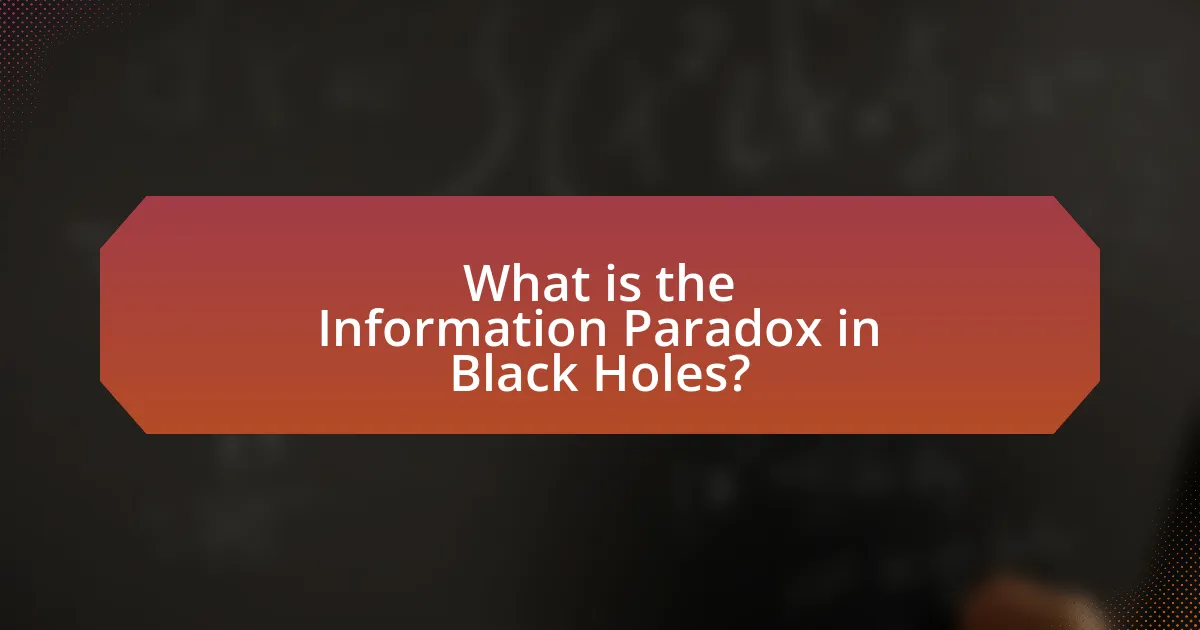
What is the Information Paradox in Black Holes?
The Information Paradox in black holes refers to the conflict between quantum mechanics and general relativity regarding the fate of information that falls into a black hole. According to quantum mechanics, information cannot be destroyed, while general relativity suggests that anything entering a black hole is lost to the outside universe. This paradox was notably highlighted by physicist Stephen Hawking, who proposed that black holes emit radiation (Hawking radiation) and eventually evaporate, leading to the potential loss of information. The debate continues, with various theories, such as the holographic principle, suggesting that information may be preserved in some form, but a definitive resolution remains elusive.
How does the information paradox challenge our understanding of physics?
The information paradox challenges our understanding of physics by questioning the fundamental principles of quantum mechanics and general relativity. Specifically, it arises from the conflict between the prediction that information about matter falling into a black hole is lost forever and the quantum mechanical principle that information cannot be destroyed. This paradox was notably highlighted by Stephen Hawking, who proposed that black holes emit radiation, leading to the potential loss of information. The implications of this paradox suggest that our current theories may be incomplete, as they struggle to reconcile the behavior of black holes with the laws governing quantum information.
What are the implications of the information paradox for quantum mechanics?
The information paradox has significant implications for quantum mechanics, primarily challenging the principle of unitarity, which states that information is preserved in quantum processes. This paradox arises from the conflict between general relativity and quantum mechanics, particularly regarding black holes, where information seemingly disappears when matter crosses the event horizon. Theoretical developments, such as the holographic principle proposed by Gerard ‘t Hooft and Leonard Susskind, suggest that all information about the matter that falls into a black hole is encoded on its surface, implying that information is not lost but rather transformed. This has led to ongoing debates and research in quantum gravity, indicating that a complete theory must reconcile these discrepancies to uphold the foundational principles of quantum mechanics.
How does the information paradox relate to the laws of thermodynamics?
The information paradox relates to the laws of thermodynamics through the concept of entropy. In thermodynamics, the second law states that the total entropy of an isolated system can never decrease over time, which implies that information, as a measure of entropy, should not be lost. When matter falls into a black hole, it appears that the information contained within that matter is lost to the outside universe, contradicting the principle of entropy conservation. This contradiction raises questions about the nature of black holes and suggests that they may not be completely described by classical thermodynamics, as proposed by Stephen Hawking’s work on black hole radiation, which indicates that black holes can emit radiation and potentially evaporate, leading to a loss of information. Thus, the information paradox challenges our understanding of thermodynamics in the context of black holes.
What are the proposed solutions to the information paradox?
Proposed solutions to the information paradox include the holographic principle, black hole complementarity, and the idea of quantum hair. The holographic principle suggests that all information contained within a volume of space can be represented as a theory on the boundary of that space, implying that information is not lost but rather encoded on the event horizon. Black hole complementarity posits that different observers may have different accounts of information, but no single observer can access all information simultaneously, thus preserving the information. Quantum hair refers to the concept that black holes may have additional quantum states that carry information, allowing for the retrieval of information that would otherwise seem lost. These solutions aim to reconcile the apparent contradiction between quantum mechanics and general relativity regarding information retention in black holes.
How does the holographic principle address the information paradox?
The holographic principle addresses the information paradox by proposing that all the information contained within a volume of space can be represented as a theory on the boundary of that space. This concept suggests that the information about matter falling into a black hole is not lost but rather encoded on its event horizon. The principle is supported by the work of theorists like Juan Maldacena, who demonstrated through the AdS/CFT correspondence that a gravitational theory in a higher-dimensional space can be equivalent to a quantum field theory on its lower-dimensional boundary. This equivalence implies that the information is preserved, resolving the paradox by indicating that it can be retrieved from the boundary, even after the matter has crossed the event horizon.
What is the role of quantum entanglement in resolving the paradox?
Quantum entanglement plays a crucial role in addressing the black hole information paradox by suggesting that information is not lost but rather encoded in the correlations between entangled particles. This concept implies that when particles fall into a black hole, their quantum states remain connected to their entangled partners outside the event horizon, allowing for the potential retrieval of information. Research by physicists such as Juan Maldacena and Leonard Susskind has demonstrated that entangled particles can preserve information through holographic principles, indicating that the information about the matter that falls into a black hole is stored on its surface, or event horizon, rather than being lost. This understanding challenges the classical view of information loss in black holes and supports the idea that quantum mechanics can reconcile with general relativity in this context.
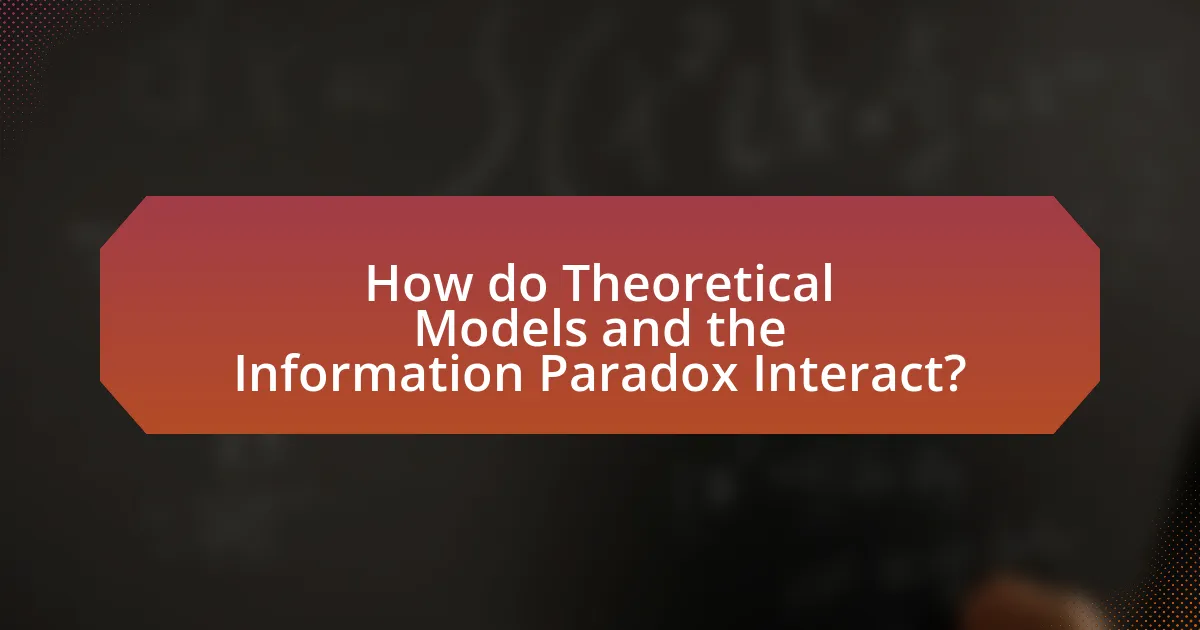
How do Theoretical Models and the Information Paradox Interact?
Theoretical models of black holes interact with the information paradox by attempting to reconcile the loss of information that occurs when matter falls into a black hole. The information paradox arises from the conflict between quantum mechanics, which asserts that information cannot be destroyed, and general relativity, which suggests that information is lost when it crosses the event horizon of a black hole. Various theoretical models, such as the holographic principle and black hole complementarity, propose mechanisms to preserve information, suggesting that it may be encoded on the event horizon or emitted as Hawking radiation. These models aim to resolve the paradox by providing frameworks that align with both quantum theory and relativity, thereby supporting the notion that information is not irretrievably lost but rather transformed.
What insights do theoretical models provide regarding the information paradox?
Theoretical models provide critical insights into the information paradox by illustrating how information may be preserved despite the apparent loss associated with black hole evaporation. For instance, the holographic principle suggests that all information contained within a volume of space can be represented as a theory on the boundary of that space, implying that information is not lost but rather encoded on the event horizon. Additionally, models incorporating quantum mechanics, such as those proposed by Stephen Hawking and later developments in quantum gravity, indicate that information could be recovered through Hawking radiation, challenging the classical view of black holes as information sinks. These insights are supported by ongoing research in theoretical physics, including studies on black hole thermodynamics and entanglement entropy, which further explore the relationship between quantum mechanics and gravitational phenomena.
How can advancements in black hole models lead to a better understanding of the paradox?
Advancements in black hole models can enhance understanding of the information paradox by providing new insights into the behavior of matter and energy near black holes. For instance, developments in quantum gravity theories, such as loop quantum gravity and string theory, propose mechanisms that could resolve the paradox by suggesting that information is not lost but rather encoded in the radiation emitted by black holes, known as Hawking radiation. Research by scientists like Juan Maldacena and Leonard Susskind has introduced concepts like the holographic principle, which posits that all information within a volume of space can be represented as a theory on the boundary of that space. These theoretical advancements offer frameworks that reconcile general relativity with quantum mechanics, thereby addressing the contradictions inherent in the information paradox.
What are the future directions for research on black holes and the information paradox?
Future directions for research on black holes and the information paradox include exploring quantum gravity theories, such as string theory and loop quantum gravity, to reconcile general relativity with quantum mechanics. These theories aim to provide insights into how information is preserved when matter falls into a black hole, addressing the paradox that suggests information is lost. Additionally, researchers are investigating the role of black hole entropy and Hawking radiation in understanding information retention, as demonstrated by studies like those from Stephen Hawking and Juan Maldacena, which propose that information may be encoded on the event horizon. Experimental efforts, such as observing gravitational waves from black hole mergers, also contribute to this research by providing empirical data that could validate or challenge existing theoretical models.
What experimental approaches are being considered to test these theories?
Experimental approaches being considered to test theories related to black holes and their information paradox include gravitational wave detection, high-energy particle collisions, and observational astrophysics. Gravitational wave observatories like LIGO and Virgo are analyzing signals from merging black holes to understand their properties and the information they might encode. High-energy particle collisions, such as those conducted at the Large Hadron Collider, aim to recreate conditions similar to those near black holes, potentially revealing insights into quantum gravity effects. Additionally, observational astrophysics focuses on studying the radiation emitted by black holes, such as Hawking radiation, to gather empirical data that could validate or challenge existing theoretical models.
What practical implications arise from understanding black holes and their information paradox?
Understanding black holes and their information paradox has significant practical implications for advancements in quantum computing and information theory. The information paradox challenges the fundamental principles of quantum mechanics and general relativity, prompting researchers to explore new theories that could unify these frameworks. For instance, insights gained from resolving the paradox may lead to the development of more efficient quantum algorithms, as they could inform how information is processed and stored at a fundamental level. Additionally, the exploration of black hole thermodynamics has implications for energy extraction methods, potentially influencing future technologies in energy production. These advancements are supported by ongoing research, such as the work by Stephen Hawking, which highlights the relationship between black hole entropy and information, indicating that understanding these cosmic phenomena can lead to breakthroughs in both theoretical physics and practical applications.

